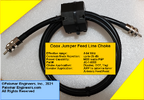Ok i am now about two weeks until my tree climber is going up my 100 plus foot tree to mount my antenna.
I have never used a CMC on a base antenna before however i am much more read then i have ever been.
So As of now my antenna choice #1 will be a original Avanti Astroplane if he installer thinks he can get it up the tree
and if he can mount it so the bottom of the hoop clears the top of the tree WITHOUT topping it. Plan 2 is for me to
have a new Imax ready in the box if needed. I did find a new in the box Max2000 however i will not know if its a 24footer
or less until i open it. Now for the questions I understand how to wrap around a 4 inch form to make a CMC should be done
but with the Astroplane I assume it should be placed Below the hoop? how far below the hoop? and if not where?
If i have to use the Imax my understanding is that without the groundplane kit it uses the coax as a counterpoise? or part of the ground?
Should i use a CMC with the IMax? Also if it matters the coax is LMR400 and near the bottom we are putting a lightning arrestor/Tap for the wire to
the ground rods would or should i put the CMC at that location? Ans because LMR400 is hard to bend i plan on using a much softer piece of coax
to make the CMC would coax would you recommend for doing this? Thank you all for reading and im sorry that i have so many questions but i only have
the climber coming for one day i cant afford to pay him to come back. What to get this right the FIRST and only time.
I have never used a CMC on a base antenna before however i am much more read then i have ever been.
So As of now my antenna choice #1 will be a original Avanti Astroplane if he installer thinks he can get it up the tree
and if he can mount it so the bottom of the hoop clears the top of the tree WITHOUT topping it. Plan 2 is for me to
have a new Imax ready in the box if needed. I did find a new in the box Max2000 however i will not know if its a 24footer
or less until i open it. Now for the questions I understand how to wrap around a 4 inch form to make a CMC should be done
but with the Astroplane I assume it should be placed Below the hoop? how far below the hoop? and if not where?
If i have to use the Imax my understanding is that without the groundplane kit it uses the coax as a counterpoise? or part of the ground?
Should i use a CMC with the IMax? Also if it matters the coax is LMR400 and near the bottom we are putting a lightning arrestor/Tap for the wire to
the ground rods would or should i put the CMC at that location? Ans because LMR400 is hard to bend i plan on using a much softer piece of coax
to make the CMC would coax would you recommend for doing this? Thank you all for reading and im sorry that i have so many questions but i only have
the climber coming for one day i cant afford to pay him to come back. What to get this right the FIRST and only time.


